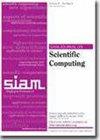应用于图像识别问题的基于领域分解的 CNN-DNN 模型并行训练架构
IF 2.6
2区 数学
Q1 MATHEMATICS, APPLIED
引用次数: 0
摘要
SIAM 科学计算期刊》,第 46 卷第 5 期,第 C557-C582 页,2024 年 10 月。 摘要深度神经网络(DNN),尤其是卷积神经网络(CNN),在解决现代计算机应用问题方面取得了重大进展。然而,随着大量数据集的不断出现和现代计算机计算能力的不断提高,DNN 和 CNN 模型的复杂性和规模也在稳步增长,从而导致训练时间的延长。因此,人们开发了各种方法和尝试来加速和并行化复杂网络架构的训练。在这项工作中,我们提出了一种新型 CNN-DNN 架构,该架构自然支持模型并行训练策略,其灵感来源于两级领域分解方法(DDM)。首先,定义局部 CNN 模型,即子网络,对输入数据的重叠或非重叠部分(如子图像)进行操作。这些子网络可以完全并行且相互独立地进行训练。然后,每个子网络针对给定的机器学习问题输出一个本地决策,该决策完全基于各自的本地输入数据。随后,在第二步中,再训练一个 DNN 模型,对本地子网络的局部决策进行评估,并生成最终的全局决策。与 DDM 类似,DNN 模型可被宽泛地解释为一个粗略的问题,因此,新方法可被解释为两级领域分解。在本文中,我们将提出的架构应用于使用 CNN 的图像分类问题。本文提供了不同二维图像分类问题、人脸识别问题和三维计算机断层扫描(CT)分类问题的实验结果。因此,我们考虑了经典的残差网络(ResNet)和 VGG 架构。更现代的架构,如 MobileNet2 等,则留待今后工作中考虑。结果表明,与全局模型相比,所提出的方法可以大大加快所需的训练时间,此外,还有助于提高基础分类问题的准确性。本文章由计算机程序翻译,如有差异,请以英文原文为准。
A Domain Decomposition–Based CNN-DNN Architecture for Model Parallel Training Applied to Image Recognition Problems
SIAM Journal on Scientific Computing, Volume 46, Issue 5, Page C557-C582, October 2024.
Abstract. Deep neural networks (DNNs) and, in particular, convolutional neural networks (CNNs) have brought significant advances in a wide range of modern computer application problems. However, the increasing availability of large numbers of datasets and the increasing available computational power of modern computers have led to steady growth in the complexity and size of DNN and CNN models, respectively, and thus, to longer training times. Hence, various methods and attempts have been developed to accelerate and parallelize the training of complex network architectures. In this work, a novel CNN-DNN architecture is proposed that naturally supports a model parallel training strategy and that is loosely inspired by two-level domain decomposition methods (DDMs). First, local CNN models, that is, subnetworks, are defined that operate on overlapping or nonoverlapping parts of the input data, for example, subimages. The subnetworks can be trained completely in parallel and independently of each other. Each subnetwork then outputs a local decision for the given machine learning problem which is exclusively based on the respective local input data. Subsequently, in a second step, an additional DNN model is trained which evaluates the local decisions of the local subnetworks and generates a final, global decision. With respect to the analogy to DDMs, the DNN models can be loosely interpreted as a coarse problem and hence, the new approach can be interpreted as a two-level domain decomposition. In this paper, we apply the proposed architecture to image classification problems using CNNs. Experimental results for different two-dimensional image classification problems are provided, as well as a face recognition problem and a classification problem for three-dimensional computed tomography (CT) scans. Therefore, classical Residual Network (ResNet) and VGG architectures are considered. More modern architectures, such as, e.g., MobileNet2, are left for future work. The results show that the proposed approach can significantly accelerate the required training time compared to the global model and, additionally, can also help to improve the accuracy of the underlying classification problem.
Abstract. Deep neural networks (DNNs) and, in particular, convolutional neural networks (CNNs) have brought significant advances in a wide range of modern computer application problems. However, the increasing availability of large numbers of datasets and the increasing available computational power of modern computers have led to steady growth in the complexity and size of DNN and CNN models, respectively, and thus, to longer training times. Hence, various methods and attempts have been developed to accelerate and parallelize the training of complex network architectures. In this work, a novel CNN-DNN architecture is proposed that naturally supports a model parallel training strategy and that is loosely inspired by two-level domain decomposition methods (DDMs). First, local CNN models, that is, subnetworks, are defined that operate on overlapping or nonoverlapping parts of the input data, for example, subimages. The subnetworks can be trained completely in parallel and independently of each other. Each subnetwork then outputs a local decision for the given machine learning problem which is exclusively based on the respective local input data. Subsequently, in a second step, an additional DNN model is trained which evaluates the local decisions of the local subnetworks and generates a final, global decision. With respect to the analogy to DDMs, the DNN models can be loosely interpreted as a coarse problem and hence, the new approach can be interpreted as a two-level domain decomposition. In this paper, we apply the proposed architecture to image classification problems using CNNs. Experimental results for different two-dimensional image classification problems are provided, as well as a face recognition problem and a classification problem for three-dimensional computed tomography (CT) scans. Therefore, classical Residual Network (ResNet) and VGG architectures are considered. More modern architectures, such as, e.g., MobileNet2, are left for future work. The results show that the proposed approach can significantly accelerate the required training time compared to the global model and, additionally, can also help to improve the accuracy of the underlying classification problem.
求助全文
通过发布文献求助,成功后即可免费获取论文全文。
去求助
来源期刊
CiteScore
5.50
自引率
3.20%
发文量
209
审稿时长
1 months
期刊介绍:
The purpose of SIAM Journal on Scientific Computing (SISC) is to advance computational methods for solving scientific and engineering problems.
SISC papers are classified into three categories:
1. Methods and Algorithms for Scientific Computing: Papers in this category may include theoretical analysis, provided that the relevance to applications in science and engineering is demonstrated. They should contain meaningful computational results and theoretical results or strong heuristics supporting the performance of new algorithms.
2. Computational Methods in Science and Engineering: Papers in this section will typically describe novel methodologies for solving a specific problem in computational science or engineering. They should contain enough information about the application to orient other computational scientists but should omit details of interest mainly to the applications specialist.
3. Software and High-Performance Computing: Papers in this category should concern the novel design and development of computational methods and high-quality software, parallel algorithms, high-performance computing issues, new architectures, data analysis, or visualization. The primary focus should be on computational methods that have potentially large impact for an important class of scientific or engineering problems.

 求助内容:
求助内容: 应助结果提醒方式:
应助结果提醒方式:


